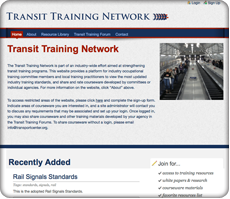News
San Diego Trolley/IBEW 465 & Tri-Met/ATU 757 Registered Apprenticeships at Rail Vehicle Trng Meeting
Posted April 2016

Center Presentation on Implementing Registered Apprenticeship Locally at Rail Vehicle Training Meeting
Registered Apprenticeship is the gold standard for preparing workers for jobs and meeting the workforce needs of businesses. It combines on-the-job learning (OJL) with related classroom instruction that increases an apprentice’s skill level and wages. Apprenticeship is an “earn and learn” model - apprentices receive a paycheck from day one, so they earn wages while they learn on the job. Across the country, over 400,000 apprentices participate every year in about 20,000 Registered Apprenticeship programs.
At the late March national rail vehicle training meeting in Charlotte, two well-established local Registered Apprenticeship programs designed for transit rail vehicle technicians were highlighted - one from Tri-Met/ATU Local 757 in Portland, OR and the other San Diego Trolley/ IBEW Local 465.
The Tri-Met and ATU 757 Rail Vehicle Mechanic Technician Apprenticeship is one of the seven transit maintenance apprenticeship programs approved by the Oregon State Apprenticeship and Training Council. The program was first implemented in the late ‘80s. The local Joint Apprenticeship Training Committee (JATC), consisting of equal numbers of management and labor representatives, oversees the program. The term of the apprenticeship is approximately 30 months, during which apprentices go through structured classroom training and OJL in safety, shop equipment, shop basics, math and applied principles, electronics, and maintenance and inspection of rail vehicle subsystems. Apprentices are offered a wage progression every six months, until they reach 100 percent at the completion. A mentoring program facilitates on-the-job learning, and mentor mechanics receive premium pay.
San Diego’s rail vehicle maintenance Apprenticeship Program is divided into two main segments: Assistant Lineman and Lineman. Each segment lasts approximately two years and consists of on-the-job training and formal classroom training. The formal classroom training may consist of attending classes at San Diego City College, or other approved local community colleges, along with formal classes held on MTS premises. MTS pays for the cost of the tuition and books. Apprentices attend classes while working full-time. At the conclusion of the Assistant Lineman Apprenticeship Program, the State of California awards the employee a Journeyman’s Certificate as an Assistant Lineman. The employee is then enrolled in the Apprentice Lineman Program. At the conclusion of the Lineman Program, the employee is awarded a Lineman’s Journeyman’s Certificate. The employee is then eligible for promotion to Electro-mechanic. Apprentices earn 34 college credits by the end of the lineman apprenticeship program. An additional 26 general education credits will be required before the trainee earns an Associate Degree in Science.
According to the apprenticeship coordinators of both programs, apprenticeship has become an effective tool for agencies to grow a highly skilled workforce for the repair and maintenance of their rail systems, while the apprentice earn a competitive wages and learn the skills necessary to move up the career ladder.
For more information on transit rail vehicle technician Registered Apprenticeship or technical assistance with your local implementation:
Download the Center Presentation Registered Apprenticeship for Rail Vehicle Technicians - National Framework, Local Implementation (shown above)
Contact Center Senior Associate Mark Dysart
